15 Most Protected Areas in the World
Although it is tempting to think that the world is on the brink of global
peace, pragmatism dictates that caution is always advised. Especially in an age
of drones, intercontinental ballistic missiles, and nuclear weapons, the need
for ample protection is not new. It hearkens back centuries, to the first
primitive stockades erected by neolithic humans. As technology improves,
security has to improve with it. With millenia of development, what are the most
well protected areas in the world today?
15) National
Redoubt, Switzerland
Perhaps the greatest example of a protected area in terms of sheer scale is the
National Redoubt. Although first started in the 1880s, it wasn't until the eve
of World War II in 1935 that it was significantly expanded and upgraded. The
reasons for this were clear: the threat of invasion by the Third Reich was a
clear and present danger. To protect Switzerland against aggression, the concept
of a National Redoubt was born. As the country could not hope to win a direct
confrontation, especially once it was surrounded from all sides by Axis
countries by 1941, the military leadership of Switzerland sought alternative
solutions.
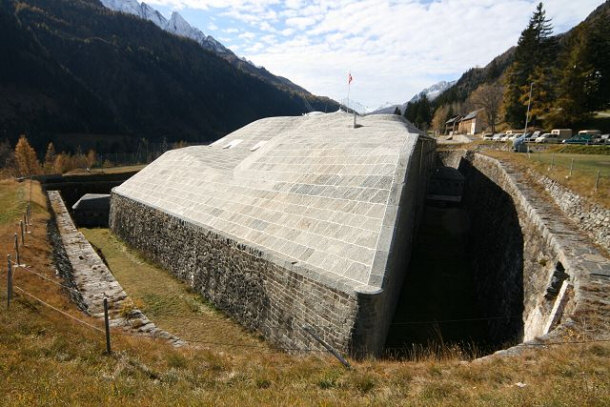
By Thomas Philipp (Own work) [CC-BY-SA-3.0],
via Wikimedia Commons
The network of fortifications was designed to create an impenetrable fortress
protecting core Swiss cantons and allowing the Confederacy to retain a
significant part of its territory, centered in the High Alps. The Redoubt
integrated mountains as natural barriers against enemy forces, with weak points
protected by camouflaged bunkers outfitted with the heaviest available weapons,
from machine gun emplacements to high caliber cannons. In the event of invasion,
all access to the region would be denied by destroying the bridges and tunnels
connecting it to the world, sealing Switzerland away from the aggressor with its
army intact. Best of all? The Redoubt still exists to this day and is routinely
reviewed to ensure that it will function in a time of need.
14) The Safe House,
Poland
When you adjust for scale, there exists a location that can easily be classified
as one of the world's most protected areas, even though it doesn't provide
security for an entire nation or gold bullion. The Safe House, located in
Warsaw, has only one goal: to provide the ultimate protection for the family
that lives in it. To the casual observer, the building is little more than an
over-sized concrete cube. However, although it does look like a bunker, it's not
intended to rein the inhabitants in.
City of Warsaw:
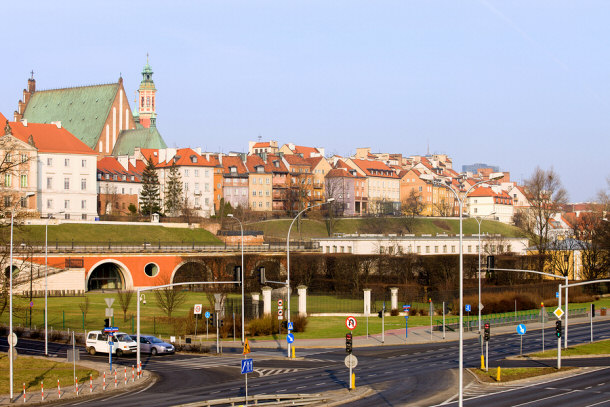
The secret lies in the dozens of mobile walls built on a lightweight steel
framework. The building can fold back large sections of its external shell and
open the inside of the house to the garden. Whenever the walls open, they draw
back and connect to the external concrete wall surrounding the building. The
only entry point is through the courtyard formed by these walls and the
reinforced entrance door. During the night, the walls fold creating a concrete
cube that provides near perfect protection from any intruders. For practical
reasons the living room is not shielded with moving walls, but a reinforced
steel shutter. All things considered, it's one of the most protected areas in
the world if you're not looking for a government bunker, but a perfectly safe
house for your family.
13) Korean
Demilitarized Zone, Korean Peninsula
The end of the Korean War in 1953, or rather, the cease-fire that was signed
that year, created one of the most protected areas on the planet. Crossing the
38th parallel, the Korean Demilitarized Zone (DMZ) is relatively small: it's 4
km wide and just about 250 km long. However, it is also the most militarized
border in the world, with both the North and South Koreans maintaining large
troop contingents on both sides of the border, ready to resume hostilities at a
moment's notice. How are soldiers are involved? The Korean People's Army in the
north has at least 1.1 million men in active service, with 8.2 million in
reserve, making it one of the largest armies in the world. The South can count
on 639,000 troops of its own, 2.9 million in reserves, and a permanent garrison
of 28,500 United States servicemen stationed in Korea.
Bunkers in the Demilitarized Zone:
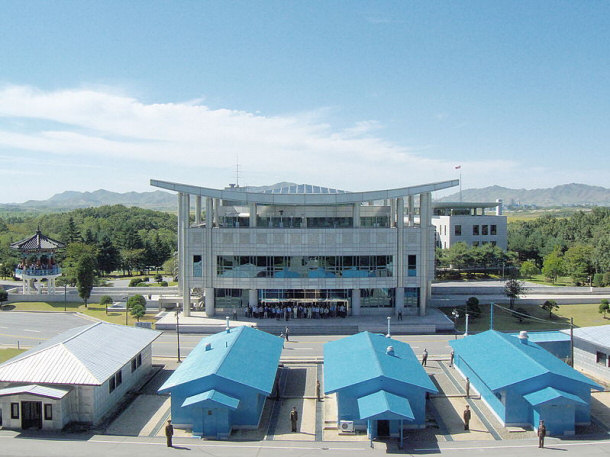
By yeowatzup from Katlenburg-Lindau, Germany [CC-BY-2.0],
via Wikimedia Commons
In terms of infrastructure, the Korean DMZ is heavily fortified on both
sides, from simple earthen defenses to concrete bunkers lining the edges of the
zone. Anti-tank barriers are a common sight, as are cul-de-sacs and landscaping
designed to create killing zones for enemy forces. It goes without saying that
both Korean states maintain extensive artillery regiments at the border,
intended to overwhelm the enemy with fire should the armistice be broken and
full out war resume. That's the scariest part: the armistice is a literal
cease-fire agreement. Since 1953, neither Korea recognized the other as a
sovereign nation, meaning that they remain in a permanent state of war.
12) Cheyenne
Mountain, Colorado, United States
The nuclear bunker that houses NORAD is one of the most iconic military
installations in modern culture, featured in dozens of movies and TV series. The
reasons for this popularity are simple: it's one of the most well protected
areas in the United States and possibly even the world. The main bunker situated
under Cheyenne Mountain is designed to withstand a 30 megaton nuclear explosion
within a two kilometer radius. For reference, the largest nuclear explosion
tested by the United States, Castle Bravo, was performed with 15 megatons. The
only nuclear weapon that would be able to defeat Cheyenne Mountain's defenses
would be a copy of the Soviet Union's Tsar Bomba: the largest nuclear bomb ever
detonated, at between 50 and 100 megatons. It was also the only one of its kind.
NORAD heavy blast doors:
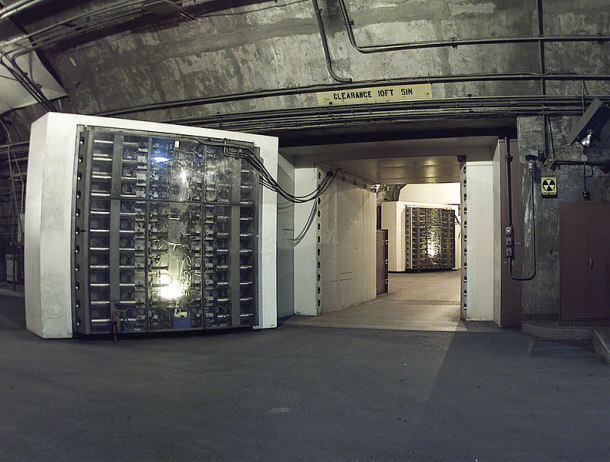
This protection is achieved by a number of factors. The most important is, of
course, the mountain and the access tunnel that runs through it. By passing
through the entire mountain, the shock wave does not concentrate at any point of
the structure. The entrance is protected by a 25-ton heavy blast door, while
interior facilities (which include everything necessary to survive the
apocalypse) are specifically constructed to protect against EMP and damage
caused by nuclear weapons or natural catastrophes. And just in case the
bombardment is followed by an invasion, the Cheyenne Mountain complex also
benefits from multiple military units stationed in the area and the facility
itself.
11) Moscow Metro,
Russia
One of the largest metro networks in the world, the Moscow underground train
network was one of the crown jewels of the Soviet Union. Extensively upgraded
and improved during the Cold War, with the threat of nuclear holocaust hanging
over the heads of both the Union and the United States, it became one of the
largest and most secure nuclear shelters in the world. Stations built during the
Cold War were specifically buried deeper underground to protect against the
bomb's shock wave and subsequent quakes, while tunnels and station entrances
were retrofitted with airlocks and blast doors to be sealed in case of an
attack.
Metro Station in Moscow, Russia:
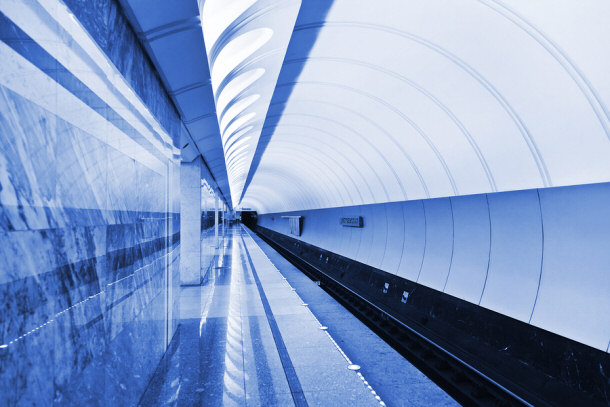
Although the Cold War is long over and the Soviet Union is no more, the vast
Muscovite network remains an important part of Russian culture and one of the
most protected locations in the world. After all, it is supposed to protect
millions of people living in the city should the Apocalypse come knocking and
allow them to survive for extended periods of time. To this end, the metro
network connects to hundreds of facilities that allow for a continued supply of
fresh water and electricity, even if the city above is laid to ruin.
10) Federal Reserve
Bank of New York Building, New York, United States
While the U.S. Bullion Depository (incorrectly referred to as Fort Knox in
common parlance) is the most widely known treasury in the United States, often
used as shorthand for security and protection, it is not the largest and most
well protected location of its type in the U.S.A. That tile belongs to the
headquarters of the Federal Reserve Bank of New York. It is currently the
largest reported gold treasury in the world, holding an estimated 25% of
worldwide gold reserves. This is not just American gold, however. The Fed also
stockpiles gold for other countries, entirely for free (only handling the gold
requires a fee).
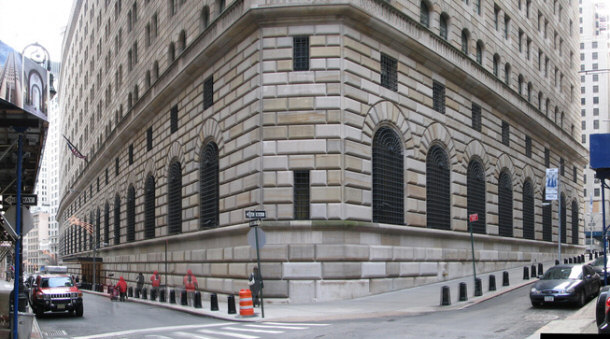
As can be expected, the building boasts impressive protection. For starters,
the building's foundation is built directly on Manhattan Island's bedrock to support over
6,700 tons of gold in storage. All access, even for routine maintenance, is
overseen personally by three members of the New York Fed staff. The facilities
are protected by a 90 ton cylinder steel door that creates an impenetrable seal
when closed, protecting the gold from danger. Coupled with around the clock
monitoring and a dedicated Federal Reserve police force, it certainly ranks as
one of the most protected areas in the world.
9) Svalbard Global
Seed Vault, Norway
While it's not intended to protect civilians or infrastructure, the Global Seed
Vault remains one of the most important well protected locations in the entire
world. Opened in 2006, it is a seed bank, designed to create optimal storage
conditions to protect against accidental loss of diversity in traditional gene
banks. In layman's terms, the facility is meant to prevent complete eradication
of plant genetic material through human action and allow for its retrieval in
emergencies. To complete this, numerous measures were taken to ensure that the
contents of the vault would not be exposed to danger.
Mountains in Svalbard, Norway:
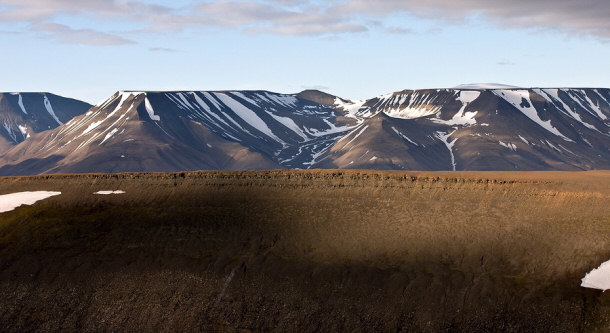
For starters, the facility is located inside a sandstone mountain on
Spitsbergen Island. The area provides exceptional protection from natural
catastrophes: there is very little tectonic activity and the permafrost ensures
that the temperature won't exceed -3 degrees Celsius, even in the case of
equipment failure inside the vault. The elevation (130 meters above sea level)
guarantees that even if the ice caps melt, the facility will not be flooded. The
remote location has its disadvantages: the facility does not have a permanent
crew. However, the passive protective measures are more than enough to protect
its invaluable contents, even for centuries if need be. An interesting note is
that the facility also incorporates a work of art, as mandated by Norwegian law.
This massive light installation is designed to double as a beacon, indicating
the location of the facility.
8) ADX Florence,
Colorado, United States
The most secure prison in the world is located in Florence, Colorado. Designated
with containing the most dangerous and/or violent criminals in the United
States, it is designed to isolate inmates from the world and minimize the risk
of escape. For starters, the entire facility is located above ground, outfitted
with hundreds of security devices like motion detectors and CCTV cameras
supplemented by over 1,400 remote controlled steel doors. However, the most
secure locations are the prison cells themselves, designed, like the rest of the
facility, to make it impossible to determine your location inside the facility
and make any attempts at making an escape impossible due to disorientation.
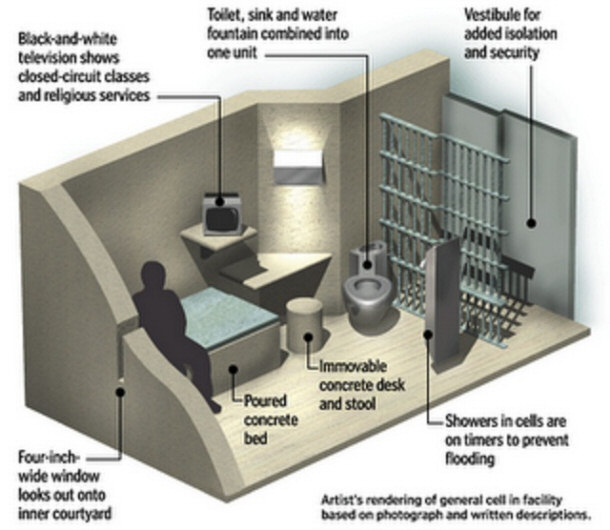
These chambers are where inmates spent over 22 hours each day, leaving them
only for the mandated five hours of physical exercise per week. The cells are
mostly made of poured concrete, which is molded to provide a bed, an immovable
desk, and a thin window that only shows the roof of the building and the sky.
Amenities are designed from stainless steel specifically to make tampering
impossible: showers operate on timers while the toilet, sink, and water fountain
are combined into one. The cell is sealed with regular bars and an additional
translucent vestibule to provide isolation. Even when they are exercising, the
inmates are kept in isolation, in an exercise pit designed to look as
featureless as possible. Escape is quite likely impossible.
7) Pionen, Sweden
Often overlooked in the listings of most protected locations in the world,
Pionen is one of Sweden's most secure locations. Originally designed as a
defense center meant to protect the government in case of nuclear war, it is
currently operated by Bahnhof, a Swedish Internet service provider, which
converted it into a data center. Servers stored inside the bunker are among the
safest in the world. For starters, like Cheyenne Mountain, the entire complex is
buried beneath the White Mountains (Vita Bergen) in Stockholm, the country's
capital.
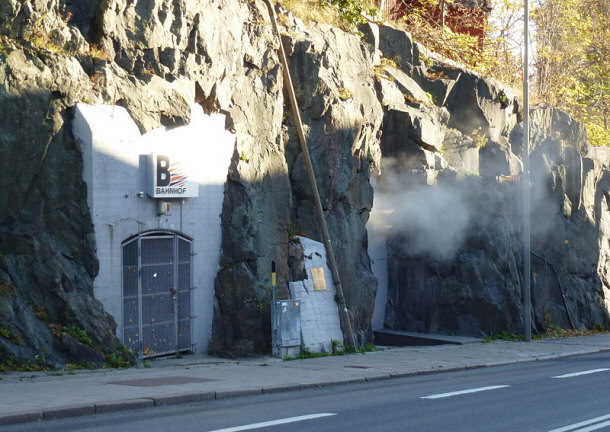
By Holger.Ellgaard (Own work) [CC-BY-SA-3.0],
via Wikimedia Commons
Access to the complex is secured by a 40 cm thick blast door, accessed
through a single entrance corridor. That's not all. On top of the extensive
network of tunnels and chambers built into the granite rock of the mountains, it
also features facilities that would plausibly allow anyone within the shelter to
survive a nuclear holocaust. These include greenhouses, a large salt water fish
tank, and backup power generators intended to power the data center should
external supply of electricity fail. All things considered, it's definitely one
of the most secure locations in the world and certainly its most protected data
center.
6) Bank of England
Gold Vault, London, England
Much like the Federal Reserve Bank in the United States, the Bank of England
stores gold for the United Kingdom and numerous other countries in a vast
underground installation buried beneath London's busy streets. The complex
network of tunnels and vaults beneath the headquarters of the Bank has an
estimated floor-space larger than the city's tallest office building, Tower 42.
The largest of these are decommissioned wells that once supplied the city with
water and now hold the world's second largest gold storage facility.
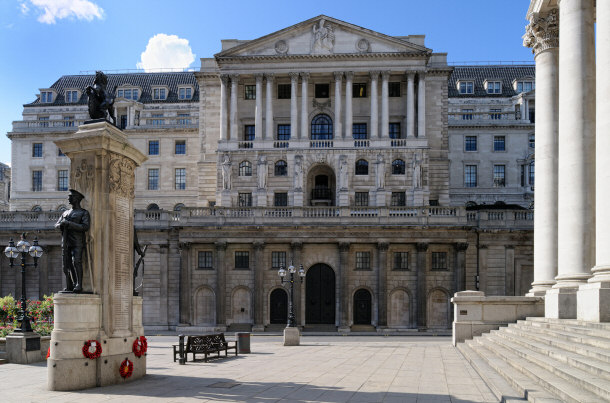
The concrete-lined vaults are specifically designed to withstand direct
bombing and did, in fact, serve as air raid shelters for the employees of the
Bank of England during the Blitzkrieg offensive in World War II. Security
protocols that protect the contents of the vaults have been constantly refined
since then and kept under strict secrecy. Very few facts are known about the
protective measures employed by the Bank. What is known, however, is that access
is granted only with the use of a triad of three foot long keys and a
sophisticated voice recognition system. Despite urban legends, the security
systems implemented in the vaults of the Bank of England have proved to be
adequate so far, with no record of a theft in the entire modern history of the
bank.
5) Area 51, Nevada,
United States
No list of the world's most protected areas can do without a mention of perhaps
the most iconic military base in modern culture. Featured prominently throughout
media, especially in science fiction, it remains one of the most mysterious
installations operated by the United States military. Originally established in
1942 as the Indian Springs Air Force Auxiliary Field, it became the Groom Lake
test facility in 1955, at first to develop the Lockheed U-2 spy plane project.
The remote area and natural features of the terrain made it a natural candidate
for one of the most secret projects of that time. The secrecy continues and to
this day no reliable information is available as to what actually happens at
Area 51.
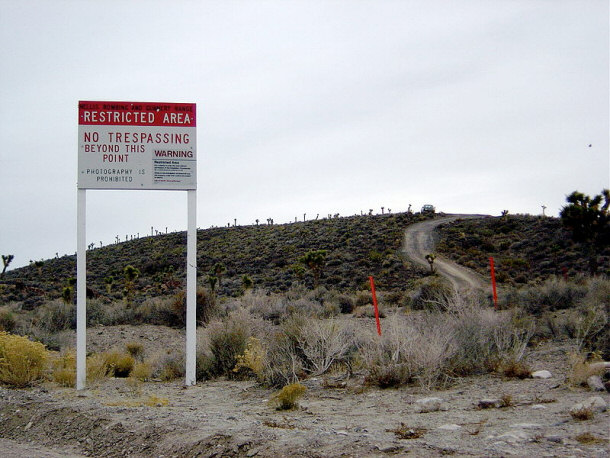
Made by X51 (Flickr:
//www.flickr.com/photos/x51/ Web:
//x51.org/) [GFDL or CC-BY-SA-3.0],
via Wikimedia Commons
To enforce secrecy, the area surrounding the lake hosting the base is
permanently off-limits to air traffic, both civilian and military. Land access
is strictly controlled, with networks of CCTV cameras securing the perimeter and
armed patrols detaining unauthorized persons. Mentions of the base are routinely
redacted from declassified materials. The secrecy surrounding the military base
is so great that in 1974, when the Skylab astronauts accidentally photographed
the site, the CIA directly intervened by requesting that NASA ensure the that
photographs become classified. No other location in the entire world is
considered as secret as Area 51. The Groom Lake facility can certainly be
classified as the world's most elusive, if not most protected area.
4) Granite Mountain
Records Vault, Utah, United States
Located in the state of Utah, the Records Vault is one of the largest archive
facilities in the world, operated by the Church of Latter-day Saints. The Mormon
Church places a heavy emphasis on genealogy in order to allow adherents of the
faith to perform baptism by proxy for their deceased relatives. The Granite
Mountain facility is specifically designed to provide a controlled, safe
environment for preserving often priceless genealogical source materials for
posterity. The installation is built into the side of Little Cottonwood Canyon,
delving over 180m into the side of the mountain.
Little Cottonwood Canyon, Utah:
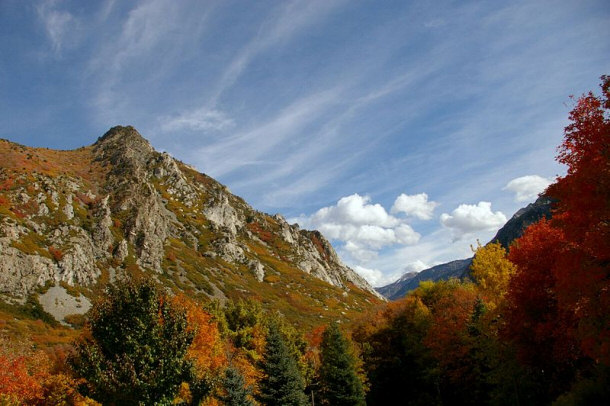
By Scott CAtron (Own work) [CC-BY-SA-2.0],
via Wikimedia Commons
The interior facilities are divided into two sections. The first one houses
the shipping and receiving areas, as well as microfilm processing stations, and
administrative offices, protected by nearly 100m of solid rock. The vault proper
is located deeper into the mountain, protected by more than 200m of granite.
Carved into the rock are six chambers with carefully regulated conditions to
provide optimal temperature and humidity for microfilmed materials. Each chamber
is filled with steel banks three meters in height, designed to protect the
contents against damage. The entire facility is rumored to be able to withstand
a nuclear detonation, although thankfully, this feature hasn't been tested thus
far.
3) Vatican Secret
Archives, Vatican City
Popularized by the books of Dan Brown, the vast archives of the Vatican and the
Papacy are widely considered to be the most secure and secretive areas in the
entire world. While indeed the Vatican Archives cannot be accessed by
unauthorized people, their contents can and are made available to scientists and
scholars that are approved, based on the purpose for which access to archival
documentation is required. The misconception that the archives are kept totally
secret from the world stems from the naming, which uses an archaic meaning of
the word secret, meaning private, rather than confidential, as the Vatican
Archives' website explains.
Vatican City in Italy:
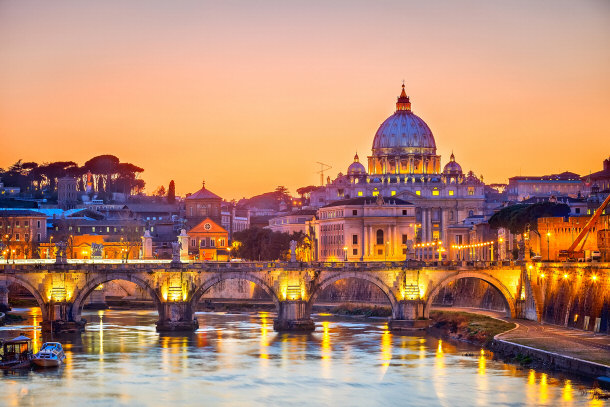
The archives themselves are designed with long term storage in mind. Since
the papacy holds documents that date back to the 12th century and earlier, the
storage facilities are designed to store materials in carefully regulated
conditions, ensuring that they will survive centuries more. The primary facility
is located in a subterranean bunker, opened in 1980 by Pope John Paul II. It
offers more than 31,000 cubic meters and 43,000 linear meters of storage with
security and climate control provided by cutting edge technology. Protection
from threats is supplemented by members of the Swiss Guard, who are sworn to
protect the Pope and the Vatican.
2) RAF Menwith Hill,
England
The development of high tech espionage was not ignored by Great Britain. The
Royal Air Force station in Harrogate, Menwith Hill, is host to one of the
largest, if not the largest, electronic monitoring stations in the entire world.
Often featured in media due to its distinctive white radar domes, Menwith Hill
was originally established in 1954 to provide the West with a means to monitor
radio communications in the Eastern Bloc. With the end of the Cold War, one
would expect that such a base would be shut down, but Menwith Hill continued
operation. In close cooperation with the United States National Security Agency,
it allegedly became a vital part of a global communications monitoring effort.
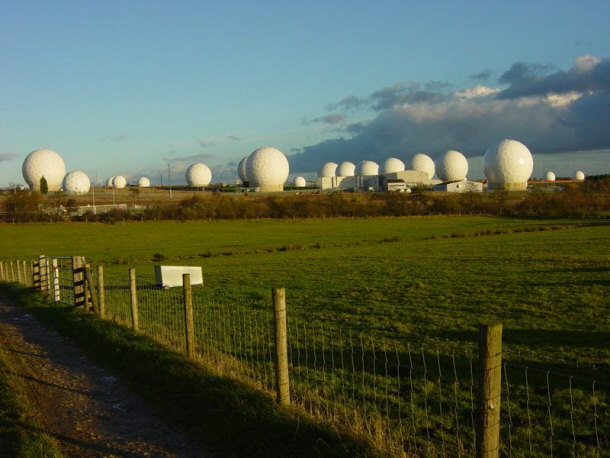
Regardless of the veracity of these claims, Menwith Hill remains one of the
most protected areas in the world. Access to state of the art communications
monitoring equipment allows the base staff to track and identify threats world
wide, while the British 451st Intelligence Squadron and the United States 421st
Air Base Group provide physical protection for the already impressively
fortified military installation. Of course, the highly publicized focus of the
base has led to a number of controversies and dozens of protests over its
operation, first focused on nuclear proliferation and strategic missile defense,
then on the alleged invasion of privacy through communications monitoring.
1) Mount Weather
Emergency Operations Center, Virginia, United States
The vast network of civil defense shelters and military installations designed
to withstand a nuclear attack are the legacy of the Cold War. Mount Weather is
no exception. Originally a 19th century weather station, Mount Weather was
established in the state of Virginia as a crucial link of the United States
continuity of government plans in 1959, when the underground facility was designed
to house the highest civilian and military officials of the United States in the
event of a national disaster.
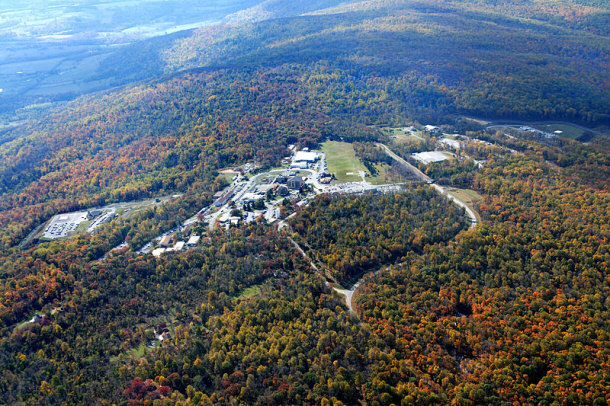
The facility is currently operated by the Federal Emergency Management
Agency. Very little information is available on the underground facilities of
Mount Weather, a trait common to all facilities involved in ensuring the
survival of the American government. What is known, however, is that the bunker
offers over 55,000 square meters of space for its inhabitants. A 1991 issue of
Time magazine featured an interview with a retired engineer that worked at the
facility. According to his statements, the bunker is a sprawling underground
installation will all the facilities necessary to ensure the survival of the
American state, including studios for broadcasting the government's messages to
the American citizens. If there's one location that can be described as the most
well protected area in the world, it's definitely Mount Weather.
Conclusion
Whether keeping something in, keeping something out, or just designed to protect
a section of the population in case of emergency, intensely-secured areas can be
found all over the world. Of course, there's one caveat: these are only the
known installations. There may be dozens of other even better protected areas
all over the world. For example, the Soviet Union and its successor, the Russian
Federation, have a particular penchant for closed cities that officially do not
exist or exist in a much different capacity than they do on paper. There are
hundreds of other countries, all with their own secret military bases and their
own highly protected areas.
Culture
Top 15 Countries With the Strongest Military
15 Amazing Architectural Style Types From Old to Modern
Top 15 Countries with the Shortest Life Expectancy
Top 15 Countries with the Best Economy
Top 15 Things You Didn't Know about Chinese Culture
Top 15 Countries with the Longest Life Expectancy
Top 15 Most Spoken Languages Around the World
15 Unique Aspects of Mexican Culture
15 Unique Aspects of German Culture
15 Unique Aspects of French Culture
15 Unique Aspects of American Culture
15 Unique Aspects of Japanese Culture
15 Ways Americans are Different than Canadians
15 Little Known Facts About Australia
10 of China's Ghost Cities Explained
20 Little Known Religions and Cults
Preparation for the 3rd Temple in Jerusalem and End Time Prophecy
Top 15 Modern Day Pirates
15 Most Protected Areas in the World
|